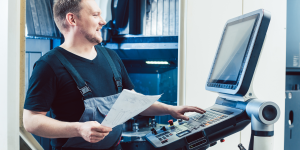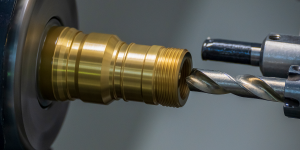CNC manufacturing has revolutionized manufacturing. It is imperative to modern manufacturing and anything made in a way that is precise, fast and accurate. CNC machining basics, advantages, fields of application, tools and equipment, safety matters, and potential professions will be covered in this article.
Learn CNC Machining Basics
The CNC machining process is operating machine tools by means of digital controls. It involves the use of pre-programmed software to control the machines so as to facilitate the production of uniform and precise products. The CAD model is a translated CNC program that controls the machine’s operations.
Not all CNC machines can do the same job, different CNC machines have different roles. CNC Mills perform the task of cutting and shaping metal and plastic. Cutting and drilling are performed on CNC lathes. Some other CNC machines are routers, grinders, as well as plasma cutters. These machines however vary according to the tools they use and the precise operations they carry out but all of them are computer-controlled.

CNC Machining Benefits: The Education Is Crucial
CNC machining is an unparalleled high level of precision and accuracy. Computer-controlled procedures eliminate human error and provide consistency. The aerospace and medical industries, which employ nanotechnology, are meant to work with this level of precision because even the tiniest deviation can be very dangerous.
The CNC machining technology is versatile and it is widespread in many applications. CNC machining is extremely necessary in aerospace, defense, automotive, medical, electronics, and construction industries. The property to manufacture complex designs and make parts that are very detailed and precise is what gives it its essentiality in manufacturing, particularly in the modern field.
CNC Machining Training and Education
The basics of CNC machining can be learned through several courses. CNC programs are available at a variety of vocational and community colleges. Students are given the opportunity to experience CNC machine operation during the practical training and theoretical under these programs. The practical experience that is provided in an apprenticeship enables students to acquire skills from the experts. This gives an opportunity to students to grow practically and learn from experience. Apprenticeships are a great way to have a hands-on experience, earn, and gain skills at the same time.
Online courses and certifications are an added option for those who want to be able to manage their studying time. These programs offer students the chance to explore the material at their own speed from everywhere in the world. Online training courses are designed to teach students about CNC machining programming, machine operation, and maintenance.
CNC Machining for Industry and Use
CNC machining is able to fulfill different tasks in all industries and it is also precise, which makes it useful. CNC machining is involved in the manufacture of jet engine turbine blades, engine parts and aircraft structural parts for aerospace and defense. In our business, CNC machining is a vital tool to manufacture geometrical shapes with close tolerances.
CNC machining is used to produce the engine, gearbox and body parts of the automotive industry. CNC machines allow the mass production of these components with same level of uniformity and precision. With the help of CNC machining, auto innovation becomes possible through prototype and individualization with quick time. CNC machining is a process that is used to make certain medical implants, prostheses as well as surgical tools. CNC parts are very appropriate for medical applications with their high precision and bio compatibility. CNC machining gives patient specific implants as a result of which treatment outcomes become more efficient and recovery time is shortened.
Through CNC machining the manufacture of circuit boards, connections, and enclosures can be done in the electronics industry. Improving on intricate designs and correcting imperfections, in turn, enhances digital devices’ functionality and lifespan. By using CNC machining, the industry can quickly produce many small components which are particular to the fast-developing electronics sector. CNC machining is used in construction as a cutting and shaping technology of metals and woods. It provides for the accurate reproduction of sculpture, ornamentation, and structural elements. CNC machines are able to handle large-volume jobs precisely and in a consistent manner.
CNC Machining Tools and Equipment: Technology Overview
CNC milling and turning are the most commonly used forms of CNC machining. CNC lathes do rotation of the workpiece against the stationary cutting tool, whereas CNC mills use rotating cutting tools. On a CNC machine there are multiple axes to travel in different directions.

The cutting tools play a major role in the CNC machining. Shape and size are chosen based on the operation. End mills, drills, reamers, and inserts are cut by the turning. The right tool should be selected considering material, finish, and cutting speed. CNC machining necessitates the use of programming languages and software. The CAD software designing the parts or components is then converted into a CNC program using CAM software. The CNC programme controls the movements of the machine, tool changes and cutting parameters. CNC machines accept the programmed instructions in the form of G or M code.
Best practises and precautions for CNC machining
Safety precedes all the operations in CNC machining to ensure operators’ safety and prevent accidents. Goggles, gloves, and ear muffs are a must in all working areas. Operators must undergo PPE training and safety procedures as mandatory requirements.
The final CNC machining safety topic relates to machine guarding. Guards and barriers should prevent the access to moving parts while machinery is in operation. In the event of an emergency, emergency stop buttons should be visible to help passengers exit the train safely. Materials need to be handled in a way that will result in fewer cases of injury. To prevent injuries related to lifting heavy or sharp objects, do it carefully and using the right technique. Material handling training and follow-up are basic requirements for operators.
CNC Machining Careers: Outlook and Prospects
CNC machinist is a job which is in demand and is one of the possible manufacturing jobs. With the growing use of CNC machining by companies in the manufacturing industry, job opportunities should also increase. CNC operators and programmers will be the ones that are needed. CNC operators salary levels depend on the years of experience, where the job is located and the industry it belongs to. Entry level jobs are one of the options that provide competitive salaries, but with more skills and experience, one is able to get a promotion which comes with higher wages. Such skills as industry experience or advanced programming even will be able to earn more salary.
CNC machining is a technology that is continuously evolving and has several opportunities for advancement. As technology improves, machine operators may be able to become supervisors or managers with training. They can be CNC programmers, tooling experts or quality control technicians. Gaining prominence in the CNC technology field necessitate continuous learning and progress. CNC machining has brought along with it features such as precision, efficiency, cost-effectiveness, and flexibility, which have seen it become an integral part of modern industries. Those who are skilled in CNC machine work may find employment in aerospace, automotive, medical, electronics, and construction industries. CNC machine hobbyists can learn CNC machining at tech schools or through apprenticeships or online courses. As the demand for skilled CNC machinists continues to rise, this could be the ideal time, making this career not only exciting but also financially rewarding.
